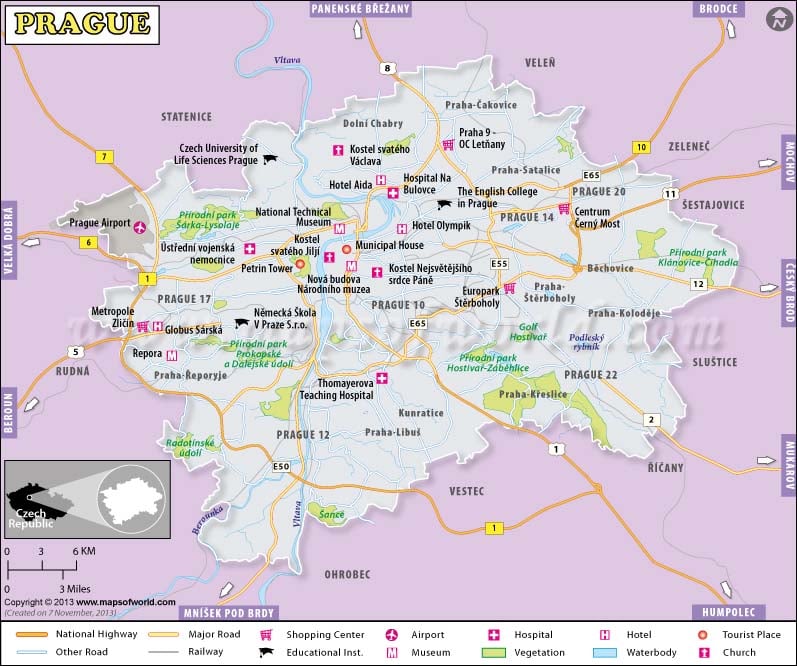About city
The city of Prague is the capital of Czech Republic in Eastern Europe. Known for its historical buildings and rich cultural heritage, Prague was the capital of Bohemia, the capital of Holy Roman Empire for some time and the capital of undivided Czechoslovakia. It is the 14th largest city of European Union covering an area of 285 sq km and had a population of 1,262,106 in 2011.
According to legends, the Czech Duchess and prophetess Libuse and her husband Premysl founded the city of Prague in the 8th century. In 800 CE, the first wooden construction appeared in the place where the Prague castle now stands. It became the seat of dukes and kings of Bohemia and the capital of the Roman Emperor Otto II. It flourished under Charles IV and became the third largest city in the Roman Empire. It reached the height of cultural development under the Hapsburgs. After the first World War, the city became the capital of Czechoslovakia. It suffered some damage during the second World War, when it was occupied by Germany. During the Cold War era, it came under Soviet influence. In 1993, it became the capital of the Czech Republic.
Geography
The city of Prague is located on the bank of the Vltava River. It occupies the basin of Bohemia. The gradual expansion of the city during its 1,100-year history has led it to occupy the adjacent hill sides and river terraces. The lowest point of the city lies 623 feet above sea level while the highest point lies at a height of 1,247 feet on the White Mountain.
Prague enjoys a mixture of humid continental and oceanic climate. Summers are warm while winters can be really cold with frequent snowfall from mid November to late March. Though overall rainfall is low, thundershowers occur in summer.
How to reach (transport)
You can reach Prague by various means. These are:
- The city is served by the international Vaclav Havel Airport Prague, which is located 20 kms to the northwest of the city. It is served by several airlines.
- Though Czech Republic has no high-speed trains, the city is well connected to the leading destinations of Europe by trains. The central station is located in the heart of the city.
- There is one station for international buses and one for regional buses in Prague. The city is well connected by road to all of Europe. The south-western highway connects the city with Germany while the south-eastern railway connects it with Slovakia.
When to visit
The summer season is the most popular tourist season but this increases the congestion at the hotels. Spring and autumn are the best times to travel to Prague. Winters are very cold, but it is the best time to enjoy Christmas festivities and the famed Music Festival.
Culture (fairs and festivals) and traditions
Several festivals are celebrated throughout the year in Prague. Some of them are as follows:
- The Bohemian Carnevale is the Czech version of Mardi Gras celebrated early in the year.
- The Saint Patrick’s Day and the Irish music festival are celebrated on 17th March.
- The Prague Easter festival is a huge musical event celebrating the composition of some of the most famous musicians of the city.
- The Prague Spring Music festival brings together artists from all over the world to celebrate music of all kinds.
- The annual Prague Food Festival is celebrated for three days with traditional dishes and children’s menu served throughout the city.
- The Prague Museum night is held in mid June, when free displays, lectures, and tours of certain museums are held.
- The Prague Folklore Days is a three-day folklore festival celebrated at the end of July. Folk customs from all over Europe are celebrated. You can enjoy folk costumes, music and dance in the historical squares.
- The Prague Christmas market is a month-long event in December marked by some great Christmas shopping and Christmas related entertainment.
Points of interest (places to visit)
There are a number of spots of historical interest in Prague. Some of them are as follows:
- Prague Old Town – also known as Stare Mesto, the old town is the first stop for visitors who visit Prague.
- The Prague castle is the biggest ancient castle in the world and has a huge picture gallery, gardens, and museums.
- The Charles Bridge is an iconic landmark, connecting Old Town with Mala Strana.
- The Old Town Bridge Tower is one of the best known examples of ancient Gothic architecture.
- The Powder Tower built in 1475 is the best medieval architecture of the city and was built as a storehouse of gunpowder.
- The Church of Our Lady Victorious is famous for the wooden statue of infant Jesus which made it a point of pilgrimage.
- The Tyn Church is the most important building on the right bank of the Vltava river.
Accommodation
Prague offers a vast variety of accommodation and the stay options here are sure to fit into the budget of most individuals, especially tourists. It includes 5-star hotels like Le Palais, Alchymist, Golden Tulip Savoy, and Corinthia, while Hotel Green Garden, Savic, Grand Hotel Praha, Perla, Union, and Denisa are the major 4-star hotels. The 3-star hotels include Hotel Rococo, William, Betlem, and Saint George. Budget accommodations are also plentiful in Prague.

 Usti nad Labem City
Usti nad Labem City